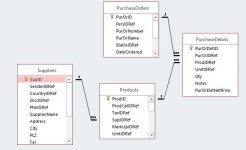silentwolf
Active member
- Local time
- Yesterday, 19:42
- Joined
- Jun 12, 2009
- Messages
- 644
Hi guys,
just wonderig your thoughs on the following relationship.
I got a Supplier table 1: n to Product table
PurchaseOrder Table 1:n to PurchOrderDetails table
Attached the Relationship.
I was wondering if I should include SupID also in the PurchaseOrders Table so I can Pick a Supplier and create a PurchaseOrder or is it better to leave the relationship as it is?
Thanks for your Input!
Cheers
Albert
just wonderig your thoughs on the following relationship.
I got a Supplier table 1: n to Product table
PurchaseOrder Table 1:n to PurchOrderDetails table
Attached the Relationship.
I was wondering if I should include SupID also in the PurchaseOrders Table so I can Pick a Supplier and create a PurchaseOrder or is it better to leave the relationship as it is?
Thanks for your Input!
Cheers
Albert


